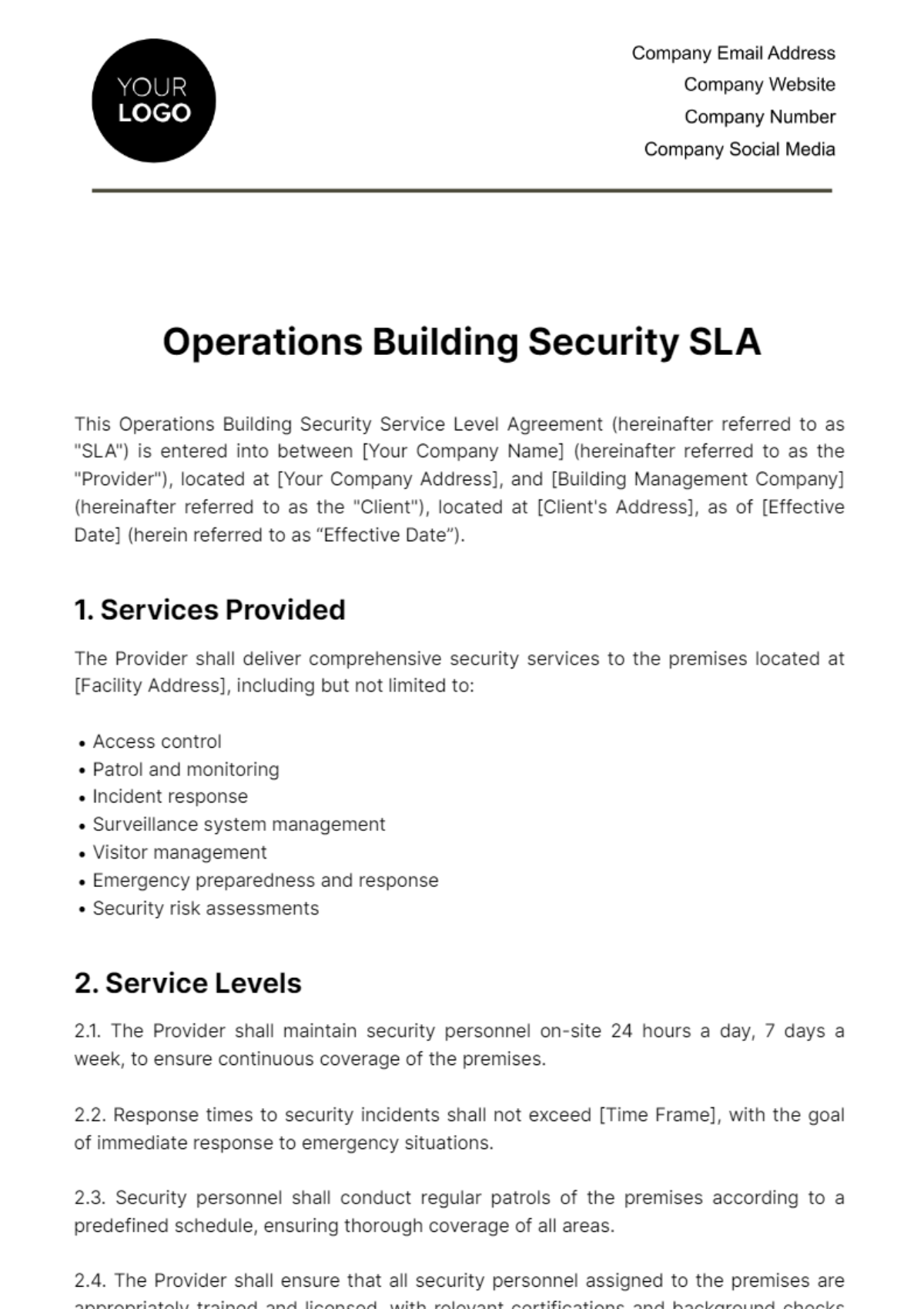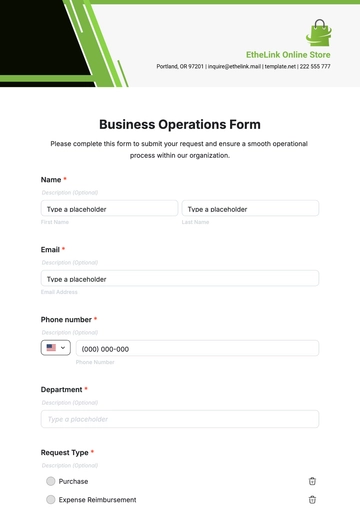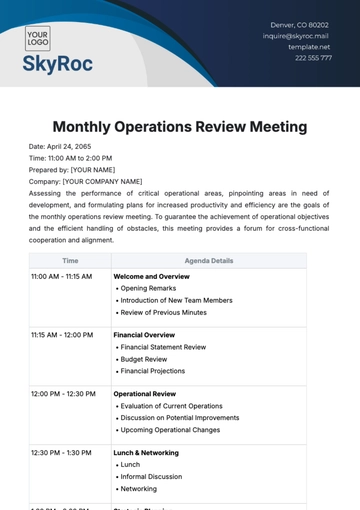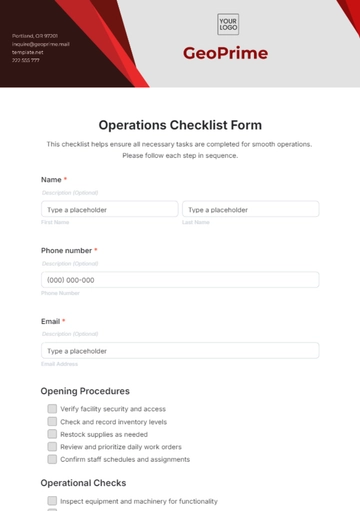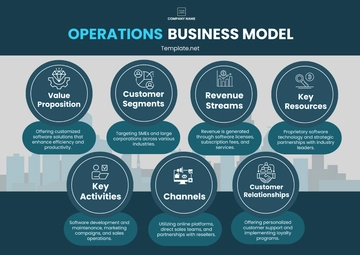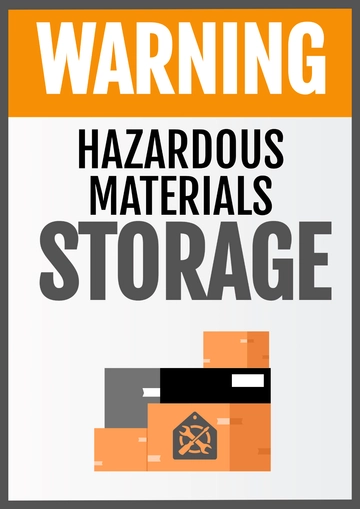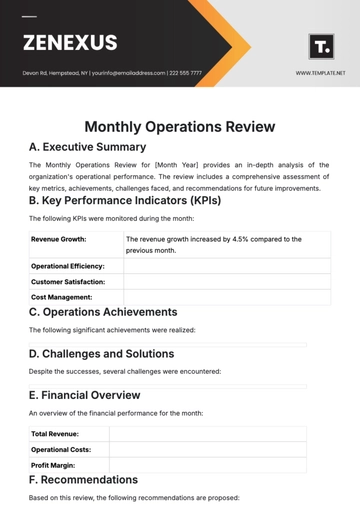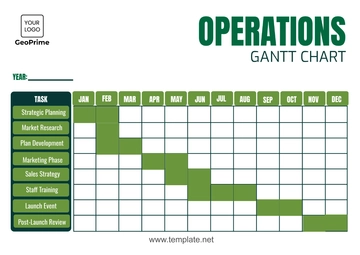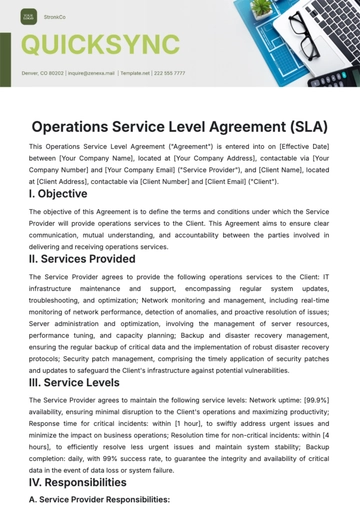Operations Building Security SLA
This Operations Building Security Service Level Agreement (hereinafter referred to as "SLA") is entered into between [Your Company Name] (hereinafter referred to as the "Provider"), located at [Your Company Address], and [Building Management Company] (hereinafter referred to as the "Client"), located at [Client's Address], as of [Effective Date] (herein referred to as “Effective Date”).
1. Services Provided
The Provider shall deliver comprehensive security services to the premises located at [Facility Address], including but not limited to:
Access control
Patrol and monitoring
Incident response
Surveillance system management
Visitor management
Emergency preparedness and response
Security risk assessments
2. Service Levels
2.1. The Provider shall maintain security personnel on-site 24 hours a day, 7 days a week, to ensure continuous coverage of the premises.
2.2. Response times to security incidents shall not exceed [Time Frame], with the goal of immediate response to emergency situations.
2.3. Security personnel shall conduct regular patrols of the premises according to a predefined schedule, ensuring thorough coverage of all areas.
2.4. The Provider shall ensure that all security personnel assigned to the premises are appropriately trained and licensed, with relevant certifications and background checks conducted.
3. Responsibilities
3.1. The Client shall provide the Provider with access to all necessary areas of the premises for the provision of security services.
3.2. The Client shall promptly inform the Provider of any changes to access control lists, security protocols, or other relevant information.
3.3. The Provider shall maintain accurate records of all security incidents, including the nature of the incident, response actions taken, and outcomes.
3.4. The Provider shall provide the Client with regular reports on security activities, including incident logs, patrol schedules, and any recommendations for improvement.
4. Escalation Procedures
4.1. In the event of a security incident requiring escalation, the Provider shall notify the Client's designated representative(s) immediately.
4.2. The Provider shall follow predefined escalation procedures as follows:
4.2.1. Initial Assessment: The first step is to assess the severity and nature of the security incident. This could involve on-site security personnel or IT staff determining the scope of the issue.
4.2.2. Internal Escalation: If the incident cannot be resolved at the initial level, it should be escalated internally within the Provider's organization. This escalation might involve notifying supervisors, managers, or a dedicated security team.
4.2.3. Client Notification: Simultaneously or shortly after internal escalation, the Provider must notify the Client's designated representative(s) as per the SLA (Service Level Agreement). This ensures that the Client is aware of the incident and can provide any necessary input or support.
4.2.4. Assessment and Decision Making: Once the Client is informed, both parties may collaborate to assess the situation further and make decisions regarding the next steps. This could involve gathering additional information, coordinating responses, or initiating further escalations.
4.2.5. External Escalation: If the incident remains unresolved or escalates in severity, external authorities such as local law enforcement or emergency services may need to be contacted. This step is crucial for addressing threats beyond the capabilities of the Provider's internal resources.
4.2.6. Documentation and Reporting: Throughout the escalation process, thorough documentation of actions taken, communications exchanged, and decisions made should be maintained. This documentation is essential for post-incident analysis, compliance purposes, and any potential legal or regulatory requirements.
4.2.7. Resolution and Recovery: Once the incident is resolved or mitigated to an acceptable level, efforts should focus on recovery and restoring normal operations. This may involve implementing additional security measures, conducting post-incident reviews, and updating security protocols to prevent future occurrences.
4.3. The Client shall designate appropriate personnel to be available for communication and decision-making in the event of a security incident.
5. Compliance and Regulations
5.1. The Provider shall ensure that all security services provided comply with applicable laws, regulations, and industry standards.
5.2. The Provider shall maintain appropriate insurance coverage for the provision of security services, including liability insurance and workers' compensation insurance.
6. Service Review and Improvement
6.1. The Provider and the Client shall conduct regular reviews of security services to assess effectiveness and identify areas for improvement.
6.2. The Provider shall implement corrective actions as necessary to address any deficiencies in service delivery.
6.3. The Client shall provide feedback to the Provider on the quality of security services and any areas for improvement.
7. Term and Termination
7.1. This SLA shall remain in effect for a period of [Initial Term], commencing on the Effective Date.
7.2. Either party may terminate this SLA upon [Notice Period] prior written notice to the other party, in the event of a material breach of the terms and conditions herein.
7.3. Upon termination of this SLA, the Provider shall promptly cease all security services and return any Client property or information in its possession.
IN WITNESS WHEREOF, the parties hereto have executed this SLA as of the Effective Date first above written.
[Your Company Name]
Representative Name:
Date: [Month Day, Year]
[Building Management Company]
Representative Name:
Date: [Month Day, Year]
Operations Templates @ Template.net
